

Threat Assessment
2002 NASRO School Resource Officer Survey (PDF)
National Association of School Resource Officers, September 2002
Produced for the National Association of School Resource Officers,
this final report presents findings from the Second Annual National
Survey of School-Based Police Officers. According to the survey, 95
percent of school-based police officers believe that their schools
are vulnerable to a terrorist attack; 79 percent believe that schools
within their district are not adequately prepared to respond to such
an attack.
Al Qaeda After
the Iraq Conflict (PDF)
Audrey Cronin, Congressional Research Service, May 23, 2003
This report analyzes current viewpoints about the strength of al Qaeda and the threat it poses to the United States. It questions whether al Qaeda can launch additional major attacks of strategic impact or whether the organization is now largely relegated to low-level tactical attacks. This report will be updated when warranted.
 Al-Qaeda
and Mass Casualty Terrorism: Assessing the Threat (PDF) Al-Qaeda
and Mass Casualty Terrorism: Assessing the Threat (PDF)
Center for Contemporary Conflict, October 2003
This report defines the threat that al-Qaeda still poses to the United States and the rest of the world, reviewing past attempts of the group to develop weapons of mass destruction and areas in the nation that may be vulnerable to and exploitable by al-Qaeda.
Al-Qaeda
Attack/Messaging Statistics, v 1.0, Public Release Version (PDF)
IntelCenter, August 22, 2003
To further an understanding of past trends and assist in threat assessment, this report provides a statistical breakdown of the timing of attacks by al Qaeda during the past 5 years. It also includes an analysis of public and semipublic messaging by this group since 1993.
Al-Qaeda Messaging/Attacks Timeline V1.6 (PDF)
IntelCenter, March 15, 2004
This timeline covers statements, other significant public and semipublic communications, and
attacks by Al Qaeda and its affiliates from January 2003 to March 15, 2004.
Al-Qaeda
Messaging/Attacks Timeline v1.5, Public Release Version (PDF)
IntelCenter, February 16, 2004
The timeline covers significant public and semipublic communications and attacks by al Qaeda
and its affiliates from January 2003 to February 16, 2004.
Al-Qaeda Targeting Guidance - v1.0 (PDF)
IntelCenter, April 1, 2004
This booklet serves as an English translation of "The Targets Inside the Cities," which appeared in Camp al-Battar Magazine, a training and targeting guide published by Al Qaeda. It advises members and jihadis across the world of specific religious, economic, and human target classes upon which to focus efforts.
America's Publicly Available Geospatial Information: Does it Pose a Homeland Security
Risk? (PDF)
RAND National Defense Research Institute, 2004
This research brief discusses an analytical process that U.S. officials can use to assess and filter
publicly available geospatial information that has homeland security implications.
Assessing the Threat of WMD Terrorism
Center for Nonproliferation Studies, August 2001
This report assesses the likelihood of a terrorist attack involving weapons of mass destruction (WMD) and recommends further empirical study based on analyses of case histories and emerging threats. The report includes a list of web-based resources for further reading.
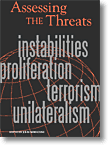 Assessing the Threats (PDF)
Assessing the Threats (PDF)
Center for Defense Information, 2002
This book examines threats to security and stability as perceived from four perspectives: American, West European, Russian, and Northeast Asian. Chapters include information focusing on current security problems, weapons of mass destruction, and various terrorist activities.
Assessing Threats of Targeted Group Violence: Contributions From Social Psychology (PDF)
National Threat Assessment Center, 1999
Recent increases in domestic and international acts of extremist violence perpetrated against American citizens have prompted an increased need for information. To help understand and evaluate the threat posed to U.S. targets by extremist groups and their individual members, this article summarizes research on group behavior and the effects of group membership on individual behavior, proposes specific questions to consider in evaluating the risk for violence by groups and by individuals influenced by groups, and suggests further research needs.
An Assessment of Non-Lethal Weapons Science and Technology (PDF)
National Research
Council of the National Academies, February 2003
Nonlethal weapons
are designed to minimize fatalities and limit undesired damage to
property and the environment. This report describes developments
in nonlethal technology, identifies promising research areas, and
addresses other issues related to nonlethal weapons, including training,
handling, and operational concepts.
Bioterrorism: Preparedness Varied Across State and Local Jurisdictions (PDF)
U.S. General Accounting Office, April 2003
This report offers information on state and local preparedness and state and local
concerns regarding the federal role in funding and improving preparedness. To gather this
information, the U.S. General Accounting Office visited seven cities and their respective
state governments, reviewed documents, and interviewed officials.
Bioterrorism
as a Public Health Threat
Emerging Infectious Diseases, July-September 1998
This article describes many aspects of bioterrorism and its prospects
for use. The author gives special attention to the possibility of
biological attacks using smallpox.
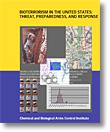 Bioterrorism in the United States: Threat, Preparedness, and Response (PDF)
Bioterrorism in the United States: Threat, Preparedness, and Response (PDF)
Chemical and Biological Arms Control Institute, 2000
This report reviews current programs that address the health and medical dimensions of national response to bioterrorism in the United States.
Building a Disaster-Resistant University (Draft) (PDF)
Federal Emergency Management Agency, May 2000
This report details
actions that universities can take to prevent and mitigate the effects
of disasters. Chapters include information on the characteristics
of a disaster-resistant university, risk assessments, and loss-reduction
plans.
Coin and Currency Production: Issues Concerning Who Should Provide Security (PDF)
U.S. General Accounting Office, July 18, 2003
This study from GAO addresses security issues at organizations (e.g., the U.S. Mint and Bureau of Engraving and Printing) that produce or handle large amounts of cash. It examines thefts and actions taken to prevent recurring thefts and analyzes the costs and benefits between using internal security and contracted security (e.g., the Secret Service Uniformed Division).
Combating Terrorism: Assessing the Threat of Biological Terrorism (PDF)
RAND, October 2001
This report presents testimony before the House Subcommittee on National Security, Veterans Affairs, and International Relations on biological terrorism—the feasibility and likelihood of terrorist groups using biological or chemical weapons and what the government can and should do to deal with biological or chemical threats.
Combating Terrorism: Assessing Threats, Risk Management, and Establishing Priorities
Center for Nonproliferation Studies, July 2000
This report presents testimony before the House Subcommittee on National Security, Veterans Affairs, and International Relations on terrorism threat assessments and risk management strategies.
Combating Terrorism: Considerations for Investing Resources in Chemical and Biological Preparedness (PDF)
Committee on Governmental Affairs, October 2001
This report presents testimony before the Senate Committee on Governmental Affairs on applying a risk management approach to determine which chemical or biological agents are of greatest immediate concern and initially investing resources in efforts with broad applicability.
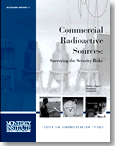 Commercial Radioactive Sources: Surveying the Security Risks (PDF) Commercial Radioactive Sources: Surveying the Security Risks (PDF)
Center for Nonproliferation Studies, January 2003
This study examines the security risks posed by commercial radioactive sources. One of the study's major findings shows that only a small percentage of commercial radioactive sources used globally pose inherent security risks. Highly radioactive materials that are easily carried and dispersed pose the greatest threat.
Countering Terrorism: A User's Guide to Understanding, Assessing and Preventing the Terrorism Threat in Arkansas (PDF)
Arkansas Department of Emergency Management
This practical guide was produced to help employers and employees devise plans to deal with potential bomb threats, as well as possible chemical, biological, and nuclear threats occurring in the workplace.
Cyber Protests: The Threat to the U.S. Information Infrastructure (PDF)
National Infrastructure Protection Center, 2001
This report discusses the growing threat of cyber protests and provides examples of recent events.
The
Darker Bioweapons Future (PDF)
Central Intelligence Agency, Directorate of Intelligence, November
3, 2003
A panel of life science experts concluded that advances in biotechnology, coupled with the difficulty in detecting nefarious biological activity, have the potential to create a more dangerous biological warfare threat.
Defending America: Asymmetric and Terrorist Attacks with Biological Weapons (PDF)
Center for Strategic and International Studies, February 2001
This report explores various aspects of bioterrorism, including possible avenues of attack, potential threats, and possible solutions and preventative measures.
The Dynamic Terrorist Threat: An Assessment of Group Motivations and Capabilities in a Changing World (PDF)
Kim Cragin and Sara A. Daly, RAND Corporation, 2004
This report assesses the threat that terrorist groups pose to the United States and to its interests overseas. It describes the tools that these groups use to maintain group cohesion and to conduct successful attacks and discusses vulnerabilities that they often face.
Emergency Preparedness Guidelines: Chemical, Biological, and/or
Radiological Incidents (PDF)
Montgomery County Public Schools, February 2003
This document includes
definitions and guidelines to help school system administrators
respond to a chemical, biological, or radiological incident. An
emergency/crisis checklist is attached.
Fact Sheet: Strengthening Intelligence to Better Protect America
The White House, January 2003
This fact sheet documents a presidential initiative to establish a Terrorist Threat Integration Center. The center, which will be part of the continued effort to close the gap between foreign and domestic intelligence analysis, will be tasked with fusing and analyzing all source information related to terrorism.
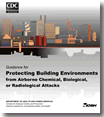 Guidance for Protecting Building Environments from Airborne
Chemical, Biological, or Radiological Attacks (PDF) Guidance for Protecting Building Environments from Airborne
Chemical, Biological, or Radiological Attacks (PDF)
U.S. Department of Health and Human Services, NIOSH, May 2002
This report identifies actions that building owners and managers can
implement to enhance occupant protection from an airborne chemical,
biological, or radiological attack. The document is not intended
to address single-family or low-occupancy residential housing.
Guide to Concealable Weapons 2003 (PDF)
Federal Bureau of Investigation, 2003
In the wake of the September
11, 2001 airline highjackings, the Firearms and Toolmarks unit of
the FBI Laboratory started to compile information on small and easily
concealed knives. This is the first installment of a continuing
effort to collect and distribute information on knives that otherwise
may be dismissed as nonthreatening items.
Guns
and Terror (PDF)
Brady Center To Prevent Gun Violence, 2001
This special report makes the case for stronger gun laws and the enforcement of existing laws, as an essential part of a comprehensive homeland security program. It contains cases studies of terrorists and guns purchased in the United States. The case studies generally involve successful use of our gun laws to prosecute those engaged in aiding terrorists.
Homeland Security: Justice Department's Project to Interview Aliens
after September 11, 2001
U.S. General Accounting Office (GAO), April 2003
In response to
the September 11 terrorist attacks, the U.S. Department of Justice
initiated a project to determine what knowledge aliens might have
of terrorists and terrorist activities. Aliens whose characteristics
were similar to those responsible for the attacks were interviewed.
GAO examined this project and recommended that because anti-terrorism
efforts will continue to rely in part on alien interview projects,
the U.S. Attorney General should institute a formal review process
and report on lessons learned.
Homeland Security: Key Elements of a Risk Management Approach (PDF)
U.S. General Accounting Office, October 2001
This report describes key elements of a good risk management approach, including assessment of threat, vulnerability, and criticality.
Homeland Security: A Risk Management Approach Can Guide Preparedness Efforts (PDF)
U.S. General Accounting Office, October 2001
This report discusses a risk management process used to consider the likelihood that a threat will endanger an asset and identifies actions that reduce the risk and mitigate the consequences of an attack.
Inspection Report: Protective Force Performance Test Improprieties (PDF)
U.S. Department of Energy, January 2004
This inspection report summarizes a protective force performance test, which determines whether
security features of a system are implemented as designed and are adequate for the proposed
environment, that was conducted at the U.S. Department of Energy's Y–12 National Security
Complex. It provides information on site safeguards, security plans, and test improprieties.
International Crime Threat Assessment
President's International Crime Control Strategy, 1998
This global assessment examines the threat posed by international crime to Americans and their communities, U.S. business and financial institutions, and global security and stability. It was prepared by a U.S. federal interagency working group in support of the President's International Crime Control Strategy.
Mapping the Risks: Assessing the Homeland Security Implications of Publicly Available
Geospatial Information (PDF)
RAND National Defense Research Institute, 2004
This report assists decisionmakers in assessing the homeland security implications of publicly
accessible geosptaial information and how such information could be exploited by terrorists or
other adversaries in attacking critical infrastructures and other key locations in the United States.
A Method to Assess the Vulnerability of U.S. Chemical Facilities (PDF)
National Institute of Justice, June 2002
This NIJ Special Report provides a prototype vulnerability assessment methodology developed to help chemical facilities identify and assess potential security threats, risks, and vulnerabilities and make security improvements.
Model Marin County School Emergency Disaster Preparedness and Incident Plan
(HTML) (PDF)
Marin County Office of Education, 1997
This plan provides a framework for protecting students, staff, and school facilities from a wide range of emergency and disaster situations. The plan, which also describes the responsibilities of school staff members, was developed by the Marin County (California) Office of Education as a tool to help formulate and implement effective emergency preparedness programs.
The New Consolidated List of Individuals and Entities Belonging to or Associated With the
Taliban and Al-Qaida Organisation as Established and Maintained by the 1267 Committee
United Nations (U.N.) Security Council, March 2004
The 1267 Committee maintains a list of individuals and entities belonging or related to the
Taliban, Osama Bin Laden, and the Al-Qaida organization. The list is available in both PDF and
HTML formats. The U.N. Security Council has obliged all states to freeze the assets, prevent the
entry into or the transit through their territories, and prevent the direct or indirect supply, sale,
and transfer of arms and military equipment with regard to the individuals/entities on the list.
Nonstrategic Nuclear Weapons (PDF)
Congressional Research Service, September 9, 2004
This report summarizes issues relating to nonstrategic nuclear weapons—nuclear mines, artillery, and short- to long-range ballistic missiles—that were deployed by the United States and Russia during the Cold War. It examines concerns surrounding Russia's weapons and the possibility that some could be lost or stolen or could have been sold to another country or group.
Nuclear Powerplants: Vulnerability to Terrorist Attack (PDF)
Carl E. Behrens, Congressional Research Service, January 31, 2002
This report reviews issues regarding nuclear power plant security following September 11, including vulnerability to assaults by land from armed terrorists and to the threat of crashing a hijacked airplane into a reactor. It discusses proposed legislation to increase security measures, including the formation of a federal nuclear guard force.
Nuclear Regulatory Commission:
Oversight of Security at Commercial Nuclear Power Plants Needs to
Be Strengthened (PDF)
U.S. General Accounting Office, September 2003
The United States' nuclear power plants are possible terrorist targets. This report identifies aspects that reduced the effectiveness of the Nuclear Regulatory Commission's oversight of security at commercial nuclear power plants and recommends two ways to strengthen it: restoring annual security inspections and revising force-on-force exercises.
Nuclear Regulatory Commission: Preliminary Observations on Efforts to Improve Security at Nuclear Power Plants (PDF)
U.S. Government Accountability Office, September 14, 2004
In this testimony before the Subcommittee on National Security, Emerging Threats, and International Relations, the Government Accountability Office (GAO) has reviewed the National Regulatory Commission's efforts since September 11, 2001 to improve security at nuclear power plants, including implementation of past GAO security and oversight recommendations.
Nuclear Security: DOE Must Address Significant Issues to Meet the Requirements of the New Design Basis Threat (PDF)
U.S. General Accounting Office, May 2004
To manage potential risks, the U.S. Department of Energy (DOE) has developed a design basis threat (DBT), a classified document that is based on information from the intelligence community that identifies the potential size and capabilities of terrorist forces. This report analyzes the current version of DBT, which was revised in May 2003 in response to the September 11 terrorist attacks.
Nuclear Security: DOE Needs to Resolve Significant Issues Before It Fully Meets the New Design Basis Threat (PDF)
U.S. General Accounting Office, April 2004
This report reviews physical security at U.S. Department of Energy (DOE) nuclear sites that house category I special nuclear material. Specifically, it details reasons why DOE needed nearly 2 years to develop a new design basis threat (DBT) ( a classified document that identifies the potential size and capabilities of terrorist forces) and analyzes the higher threat contained in the new DBT.
OECD
Guiding Principles for Chemical Accident Prevention, Preparedness
and Response: Guidance for Industry (including Management and Labour),
Public Authorities, Communities and Other Stakeholders (Second Edition)
(PDF)
Organisation for Economic Co-Operation and Development, November
2003
This comprehensive document will help public authorities, industry, and communities worldwide prevent and prepare for accidents involving hazardous substances resulting from sabotage and technological and natural disasters. It discusses topics such as the development of a health infrastructure to deal with chemical accidents, implementation of principles by small and medium-size enterprises, chemical safety at transport interfaces, and guidance for audits and inspections.
Osama
bin Laden Audio Release Analysis: v1.1 (PDF)
IntelCenter, January 4, 2004
This six-page report examines the correlation between the timing of the release of Osama bin Laden audiotapes and major attacks by al Qaeda. It includes details on the Osama bin Laden audiotape released on January 4, 2004 and its impact on the threat environment.
Proactive Guide for the Threat of Terrorism in Schools (PDF)
Texas School Safety Center, Southwest Texas State University, 2003
This guide addresses the possibility that terrorists may target schools. A significant portion of the information contained in the guide is compiled from various federal, state, and local agencies responsible for keeping the public safe and informed.
Protecting Against the Spread of Nuclear, Biological, and Chemical Weapons: An Action Agenda for the Global Partnership (PDF)
Center for Strategic & International Studies, January 2003
This report seeks to facilitate achievement of the goals outlined in the G-8 Global Partnership by identifying solutions to bureaucratic and other obstacles that have hampered past threat-reduction activities. Specifically, the report outlines a future agenda and addresses key challenges in making the global partnership work, including how the political momentum for such an effort should be sustained and how to meet the $20 billion funding goal identified at the G-8 2002 summit.
Volume 1: Agenda for Action
Volume 2: The Challenges
Volume 3: International Responses
Volume 4: Russian Perspectives
Protecting the American Homeland: One Year On (PDF)
The Brookings Institution, January 2003
This report provides an
overview of the nation's anti-terrorism activities and suggests
additional ways to successfully combat terrorism at home and abroad.
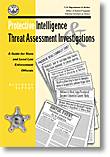 Protective Intelligence and Threat Assessment Investigations: A Guide for State and Local Law Enforcement Officials (ASCII or PDF)
Protective Intelligence and Threat Assessment Investigations: A Guide for State and Local Law Enforcement Officials (ASCII or PDF)
National Institute of Justice, January 2000
This report describes protective intelligence and threat assessment investigations, focusing on protocols and procedures for law enforcement and security agencies responsible for protecting public persons and others who are vulnerable to targeted violence.
Remarks Before the National Commission on Terrorist Attacks Upon
the United States (PDF)
RAND Corporation, March 2003
This testimony addresses the nature
of the current terrorist threat, the goals of a counter-terrorism
strategy, and the use of intelligence to deal with terrorism.
Report of the Defense Science Board Task Force on Preventing and Defending Against Clandestine Nuclear Attack (PDF)
U.S. Department of Defense, June 2004
This report addresses the threat of nuclear attack against the United States delivered by means other than missiles or aircraft—in effect, hidden and smuggled nuclear weapons, devices, or materials.
Risk Management and Critical Protection: Assessing, Integrating, and Managing Threats, Vulnerabilities and Consequences (PDF)
Congressional Research Service, September 2, 2004
This report discusses the efforts of the U.S. Department of Homeland Security and its Information Analysis and Infrastructure Protection Directorate to carry out duties involving coordination of national activities to protect critical infrastructure, including using a risk management approach to set priorities.
Security Clearances: FBI has Enhanced its Process for State and Local Law Enforcement Officials (PDF)
U.S. General Accounting Office, April 2004
This report describes the FBI's procedures for granting security clearances to state and local law enforcement, the extent to which the FBI has met time-based goals for deciding/clearing applications, and its efforts to enhance this process.
Security:
Counterfeit Identification and Identification Fraud Raise Security
Concerns (PDF)
U.S. General Accounting Office, September 2003
This report summarizes investigations that demonstrate security vulnerabilities that exist because counterfeit identification can be easily produced and used to create fraudulent identities. Tests revealed security weaknesses at federal buildings and other facilities, airports, and our nation's borders,
and exposed identity fraud vulnerabilities in both the application process for a Social Security number and in the administration of federal gun control laws.
The Sociology and Psychology of Terrorism: Who Becomes a Terrorist and Why? (PDF)
Federal Research Division, Library of Congress, September 1999
This study examines the types of individuals and groups that are prone to terrorism in an effort to help improve U.S. counter-terrorism methods and policies. The study examines relevant literature to assess the current knowledge of the subject and develops psychological and sociological profiles of foreign terrorist individuals and selected groups to use as case studies in assessing trends, motivations, and likely behavior, as well as reveal vulnerabilities that would aid in combating terrorist groups and individuals.
Terrorists
and Suicide Attacks: CRS Report for Congress (PDF)
Congressional Research Service, The Library of Congress, August
2003
Suicide attacks by terrorist organizations have become more prevalent globally, causing an interest in the threat of suicide attacks against the United States both at home and abroad. This report analyzes key lessons from the international experience with suicide attacks and examines their relevance to the United States.
Threat Assessment in Schools: A Guide To Managing Threatening Situations and To Creating Safe School Climates (PDF)
U.S. Secret Service and U.S. Department of Education, May 2002
This document establishes a process for identifying, assessing, and managing students who may pose a threat of targeted violence in schools. The guide's intended audience includes school personnel, law enforcement officials, and others with protective responsibilities in the nation's schools.
Tribal Lands Homeland Security Report
National Native American Law Enforcement Association, February 2003
This report chronicles the findings of the National Native American Law Enforcement Association’s Summit on Homeland Security on Tribal Lands. The main purpose of the summit was to define the nature of the homeland security threat on tribal lands and to discuss the level of preparedness to meet that threat.
Understanding the Bioterrorist Threat: Facts and Figures (PDF)
The Heritage Foundation Backgrounder, October 2001
This article reviews the facts about various biological agents and their potential effects. Although obstacles to mounting a biological attack against America may appear daunting, they can be overcome.
Vehicle Bomb Mitigation Guide
Technical Support Working Group, January 2004
This guide presents reference materials for planning and executing programs and operations for protecting personnel and assets against the threat of vehicle bombs. It's available in a waterproof flip chart format and presents lessons learned from several major U.S. Air Force Protection Battlelab initiatives. Due to security concerns, this publication is restricted. To order a copy, send an e-mail request to pubs@tswg.gov and include the quantity desired, contact name, organization name, address, and telephone number. Once the request is approved, copies may be ordered directly through the Government Printing Office at orders@gpo.gov or via fax at 202-512-2250.
What Every Public Safety Officer Should Know About Radiation & Radioactive Materials (not yet available online)
National Law Enforcement Corrections & Technology Center (NLECTC),
February 2003
Developed in cooperation with the Law Enforcement
Technology Support Center at the U.S. Department of Energy's Savannah
River Technology Center, this brochure is a quick-reference guide
for public safety personnel. It provides basic information about
radiation, radiation hazards, and initial response. It is not intended
to replace an agency's existing policies, procedures, or training.
Agency response protocols should be developed and followed for responding
to incidents of suspected weapons of mass destruction. Hard copies
of this publication will be available soon. Call NLECTC at 800-248-2742
or e-mail to be placed on the mailing list for this brochure.
|













